A sound wave is a mechanical disturbance that propagates through a medium such as air, water, or solids, carrying energy and information via oscillations of pressure and particle displacement. It encompasses a broad range of frequencies, including those audible to humans (20 Hz to 20 kHz) as well as infrasound and ultrasound, and is fundamental to numerous applications in communication, music, medical imaging, and environmental monitoring.
A sound wave, also known as an acoustic wave, is a type of mechanical wave that propagates through a medium—such as air, water, or solids—due to the vibration of an object. It is characterized by its ability to carry energy and information through the medium, manifesting in physical properties such as frequency, amplitude, wavelength, and speed. Sound waves are fundamentally longitudinal waves, where the displacement of the medium is parallel to the direction of wave propagation, leading to regions of compression and rarefaction.
The term “sound pressure wave” is often used in a broad sense to refer to waves within the audible range for humans, approximately between 20 Hz to 20 kHz. In contrast, “acoustic wave” is a term preferred in scientific, engineering, and technical contexts, encompassing both audible sound and air pressure waves outside the human hearing range, including infrasound (below 20 Hz) and ultrasound (above 20 kHz). This distinction highlights the versatile nature of sound waves, which are not only crucial for communication, music, and environmental interaction but also play pivotal roles in various applications such as medical imaging, industrial diagnostics, and environmental monitoring.

The properties of acoustic waves encompass several key characteristics that describe their behavior as they propagate through a medium. These properties not only define the physical aspects of sound waves but also influence how they interact with their surroundings and are perceived by humans or detected by instruments. Here’s a detailed overview:
Frequency: The number of oscillations or cycles that occur in a sound wave per second, measured in Hertz (Hz). Frequency of a sound wave determines the pitch of the sound, with higher frequencies producing higher-pitched sounds and lower frequencies resulting in lower-pitched sounds.
Wavelength: The physical distance between two consecutive points in phase on a wave, such as crest to crest or trough to trough. Wavelength of a sound wave (λ) is inversely proportional to frequency and directly related to the speed of sound (c) and the wave’s frequency (f) by the formula λ=c/f.
Amplitude of a sound wave represents the maximum displacement of particles from their equilibrium position due to the passage of the wave. In sound waves, amplitude is related to the loudness or volume of the sound, with larger amplitudes producing louder sounds.
Speed: The rate at which a sound wave travels through a medium. The speed of sound varies depending on the medium and its properties (e.g., density, temperature, and elasticity), being fastest in solids, slower in liquids, and slowest in gases.
Intensity: The power carried by a sound wave per unit area, measured in Watts per square meter (W/m2). Intensity is a measure of the energy of the sound wave and is related to both its amplitude and distance from the source, influencing how loud the sound is perceived.
Phase: describes the position of a point in time on a waveform cycle. In the context of multiple interacting waves, phase differences can lead to phenomena such as constructive or destructive interference, significantly affecting the resultant sound’s amplitude and intensity.
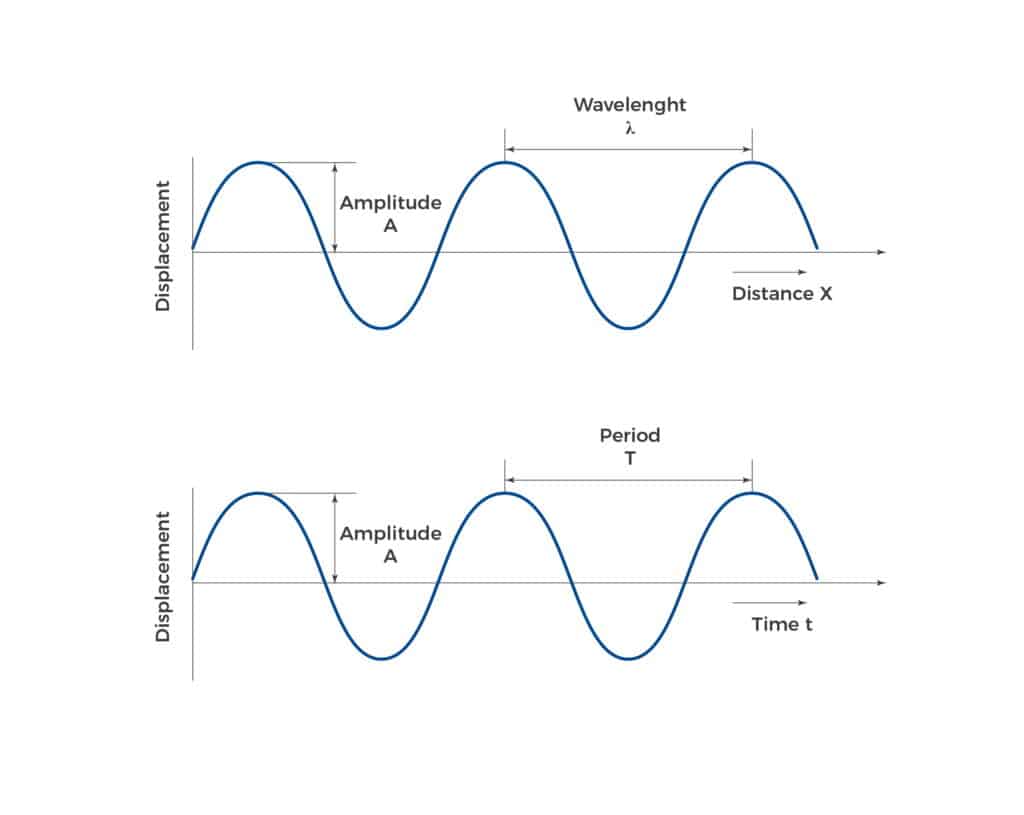
Acoustic waves can be categorized based on their propagation mode, frequency range, and the medium through which they travel. Here’s a closer look at the primary types:
Types of Waves Based on Propagation Mode
Types of Waves Based on Frequency
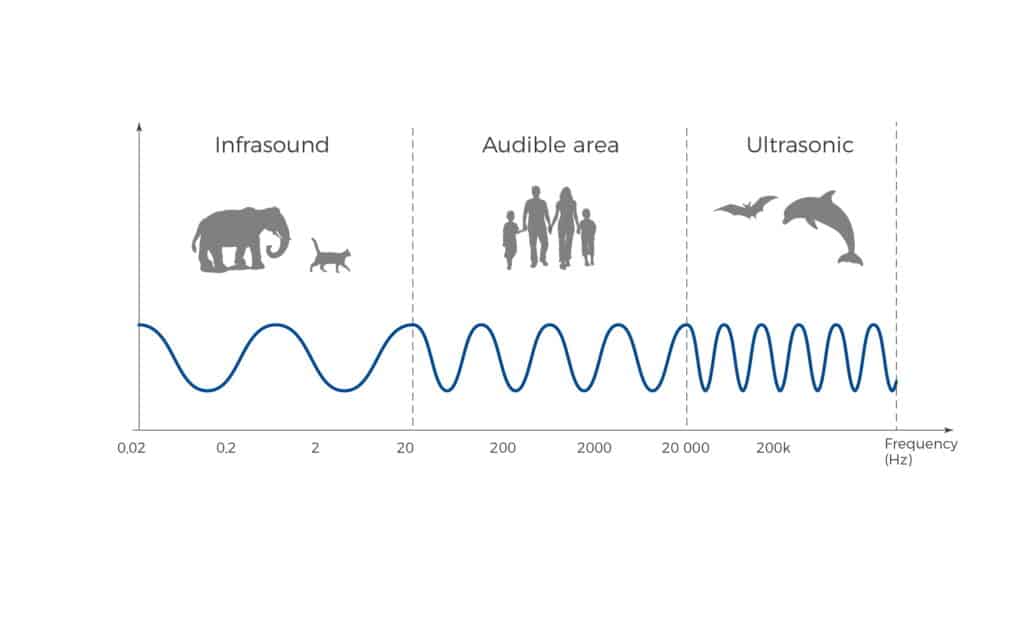
Standing waves are a unique phenomenon resulting from the interference of two waves traveling in opposite directions with the same frequency. They are characterized by nodes (points of no movement) and antinodes (points of maximum oscillation). Standing waves are fundamental in the study of musical instruments, architectural acoustics, and the design of resonant cavities for various applications. Understanding how standing waves form and their properties helps in the precise control and manipulation of sound in spaces and devices.

The transfer of sound energy by a wave is related to the movement of particles and the passing of energy through the medium.
In a sound wave, the particles of the medium (such as air molecules) move back and forth in a direction parallel to the wave’s direction of propagation (similiar to a tuning fork), but they do not themselves travel with the wave over long distances. Instead, it’s the energy that the wave carries that moves forward through the medium.
This movement of particles back and forth results in compressions (areas where the particles are closer together) and rarefactions (areas where the particles are further apart), which propagate through the medium as the sound wave travels. The particles oscillate around their equilibrium positions – they move back to where they started once the wave has passed.
The energy transfer occurs as follows:
Initiation: The sound wave is initiated by a vibrating source (like a speaker or a plucked guitar string), which pushes particles in the medium closer together (compression) or pulls them further apart (rarefaction).
Transmission: As one particle is displaced from its equilibrium position, it exerts a force on its neighboring particles due to the pressure difference, causing them to move as well. This process repeats from particle to particle, transmitting the sound energy through the medium.
Propagation: Although individual particles only move a small distance back and forth, the energy of the sound wave is passed along from particle to particle, allowing the wave to propagate through the medium and carry sound energy over significant distances.
Reception: When the sound wave reaches a listener (or a measuring device), the oscillating pressure changes cause the listener’s eardrum (or the device’s diaphragm) to vibrate, enabling the sound to be heard or measured.
This efficient transfer of energy, from particle to particle, without the bulk movement of the medium itself, is what allows us to hear sounds from sources that are far away, as the energy from the sound source is transmitted through the medium to reach the listener.
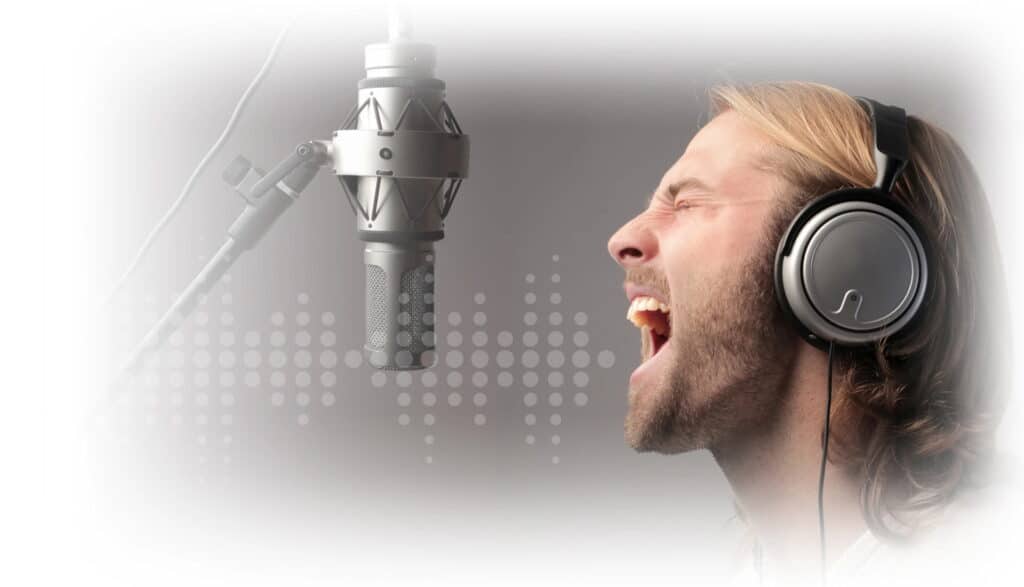
Focusing on the graphical representation of sound waves, we utilize the sine function to illustrate the oscillatory nature of these waves, capturing the essence of sound propagation through different mediums. In this context, zero crossings in the sine wave graphically represent moments when the sound pressure level is equal to the ambient pressure, indicating a change in the direction of particle movement within the medium. These crossings are pivotal in understanding the wave’s phase and its interaction with the environment or other waves.
The wave’s period, visually shown by the distance between consecutive peaks or troughs on the graph, directly correlates to the frequency of the sound wave. Frequency, measured in Hertz (Hz), denotes the number of oscillations per second and is inversely related to the period; higher frequencies correspond to shorter periods and vice versa. This relationship is fundamental in acoustics, dictating the pitch of the sound perceived by the human ear.
Amplitude, another critical property of sound waves, reflects the maximum extent of a vibration or oscillation from the position of equilibrium, which can be measured in Pascals (Pa) for linear representation or decibels (dB) for a logarithmic scale. The amplitude is indicative of the sound’s loudness; higher amplitudes result in louder sounds. In graphical terms, amplitude is represented by the height of the wave peaks from the central axis (zero line) on the sine graph.
Complex sound waves, which are typically encountered in real-world scenarios, can be decomposed into simpler sine waves through a process known as Fourier analysis. This decomposition allows for the extraction of the fundamental frequencies and their harmonics, facilitating a deeper understanding of the sound’s characteristics and enabling effective postprocessing in acoustics. This analytical approach underscores the significance of sine wave representations in visualizing and interpreting the intricate nature of sound waves.
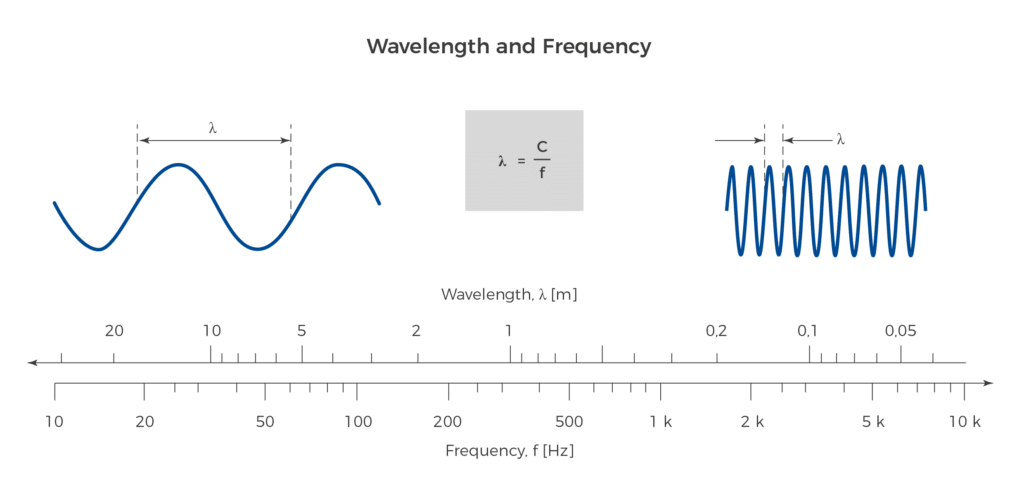
In acoustics, sound waves are often employed extensively for analyzing and enhancing the acoustic characteristics of environments, from concert halls and recording studios to public spaces and residential areas. This process often involves the use of sound generators and sound level meters as key tools for measuring acoustic properties and implementing necessary adjustments for optimal sound quality.
Through this methodical approach—employing sound generators to create a controlled acoustic environment and using sound level meters for precise measurement and analysis—acousticians can significantly improve a room’s acoustic characteristics. This ensures that the space not only meets aesthetic and functional requirements but also provides an auditory experience that enhances the overall environment for its occupants.

In an anechoic chamber, waves are used to create a controlled environment that simulates free-field conditions, allowing for the precise measurement and analysis of sound without the influence of reflections or external noise. The design of an anechoic chamber focuses on minimizing reflections (echoes) and maximizing absorption to ensure that sound waves emanating from a source do not bounce back from the walls, ceiling, or floor. This is achieved through the use of sound-absorbing materials that cover all internal surfaces of the chamber, typically in the form of wedge-shaped foam or fibrous baffles.
The primary use of waves in an anechoic chamber involves:
Measurement and Testing: Acoustic measurements of devices such as loudspeakers, microphones, and other audio equipment are performed in anechoic chambers. The lack of reflections ensures that the measurements capture only the direct sound from the source, providing a clear and uncolored assessment of its acoustic output.
Research and Development: Engineers and researchers use anechoic chambers to study the properties of sound waves and their interaction with various materials. This controlled environment is ideal for developing new audio technologies, materials with specific acoustic properties, and noise reduction techniques.
Sound Characterization: By eliminating reflections, anechoic chambers allow for the precise characterization of the sound emitted by objects, including their frequency response, directivity patterns, and emission levels. This information is crucial for designing sound systems, architectural acoustics, and noise control solutions.
Plane Wave Generation: In anechoic chambers, speakers can be used to generate plane waves that mimic the behavior of sound in an open, unbounded environment. These plane waves are essential for calibrating and testing microphones and other sensors under conditions that closely resemble real-world, free-field sound propagation.
By focusing on absorption and minimizing reflection, anechoic chambers utilize sound waves to provide an ideal setting for accurate acoustic measurements and research, enabling advancements in audio technology and the study of sound behavior in near-perfect free-field conditions.
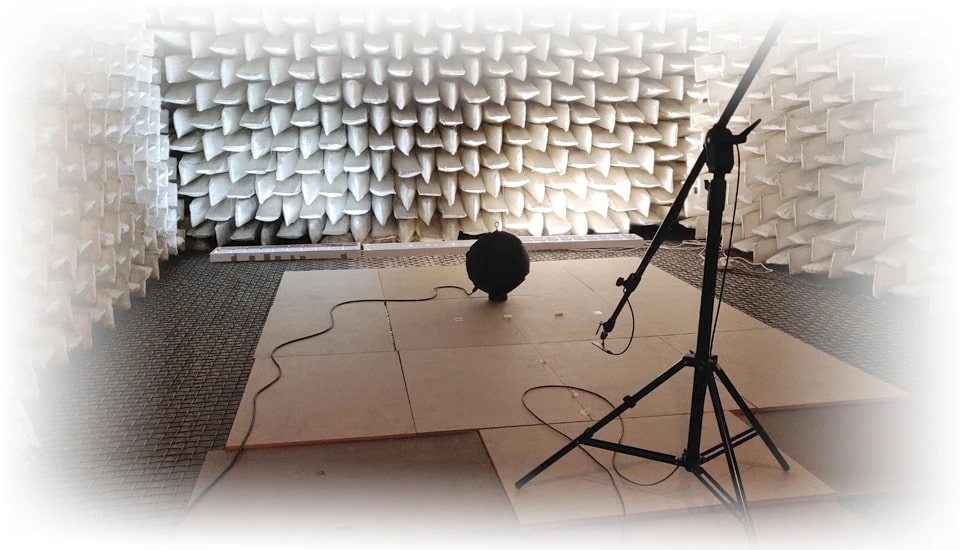
Sound waves, or acoustic waves, are mechanical waves that travel through media (air, water, solids) due to object vibrations, characterized by frequency, amplitude, wavelength, and speed. These waves can be longitudinal or transverse, depending on the direction of particle displacement relative to wave propagation.
The behavior of sound waves is defined by several properties, including frequency, which determines pitch; amplitude, related to loudness; speed, which varies with the medium; and intensity, indicating energy transfer.
Acoustic waves vary based on their propagation mode (longitudinal, transverse, surface waves) and frequency range (audible sound waves, infrasound, and ultrasound), each with distinct characteristics and applications.
Resulting from the interference of two waves traveling in opposite directions, standing waves are essential in music, architectural acoustics, and the design of resonant cavities.
Sound energy is transferred through the medium by the oscillation of particles, with energy moving forward while the particles themselves only oscillate around their equilibrium positions.
Sound waves are commonly visualized using sine functions, illustrating key aspects such as frequency, amplitude, and phase. Complex waves can be decomposed into simpler waves for analysis.
Sound waves are utilized in acoustics to analyze and improve the acoustic characteristics of environments. Techniques involve generating specific noise types (like pink or white noise) and analyzing the room’s response to optimize acoustics.
Anechoic chambers are specialized environments that simulate free-field conditions for precise acoustic measurements and research, focusing on minimizing reflections and maximizing absorption.